HEAT DISTRIBUTION IN 3D PRINTING ARCHITECTURE
Abstract

This research thrives to explore the methods of heat distribution mechanism for cold climates enhancing a sustainable indoor thermal Performance. In searching different theories and principles of thermodynamics and 3d printing architecture using clay. There will be physical and digital models or experiments to address numerous means of geometric alteration between cavity and mass of a 3d printed clay wall. A physical experiment based on a ‘ thermal physical environment ’ is created to measure temperature changes of a volume using a thermal camera and thermistor sensors both inside the environment and infill mass.CFD and steady-state heat transfer models created digitally using software and cloud computing in order to understand a computer-based assessment of convection and conduction heat transfer in addition to the physical world. Moreover, Based on vernacular and state of art references the paper will add a sustainable approach in solving a heat distribution for minimal use of active heat source in cold outdoor temperature using the chimney. There are limits regarding physical measurements and data extraction in terms of relating data to digital computing.
A goal to minimize the active heating mechanism by enhancing the conducting and resisting capability of clay and coupling a mass and cavity for a performance-based geometric design of a 3d printed wall will of course add the content of research in terms of sustainable architecture.
Introduction
A study on how the conscious design of cavity and mass in a 3D printed wall can upgrade a sustainable heating demand in creating a better heat distribution through cavity component.
Research questions
What are the benefits of clay 3d printed wall in inducing heating for cold climates compared to the conventional chimney?
Concept of research
By applying a source, the cavity in the printed wall channel the heat from one point to another or multiple points. More than that, the cavity heats up and it, in turn, heats the mass. After a certain period of time, the source deactivates, the stored heat starts to dissipate into indoor space gradually. The coupled mass and cavity helps to heat the space sustainable manner.
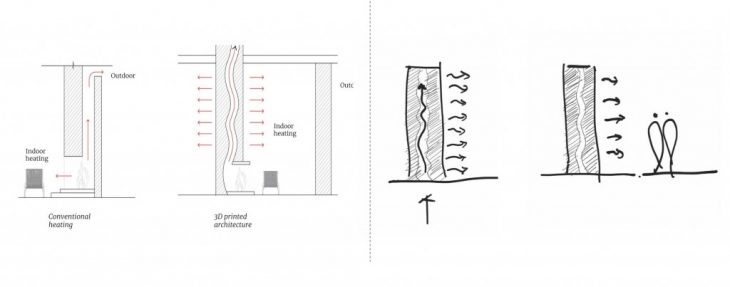
Components of a wall
Making it better thermal performance and transmission, a 3D printed wall consists cavity, mass and insulation chamber. Evermore we can add different laver and chambers based on the performance anticipated and the spatial interaction of our wall.

Geometric exploration and variables
A serious of thermodynamic principles are to be iterated in terms of cavity and surface are. The volume of mass is also directly proportional to the energy to be stored for further heating of a space. Sorting them specifically area inters of cavity distribution and Surface are of contact inside the cavity chamber. And, coming to Mass the volume and surface are areas of emittance are studied.
A serious of catalogue were made for understanding and measuring the quantitative data by coupling a constant mass and cavity ratio.

Showing below two samples to be tested are printed to understand the effect of surface area in relation to room radiation of heat.
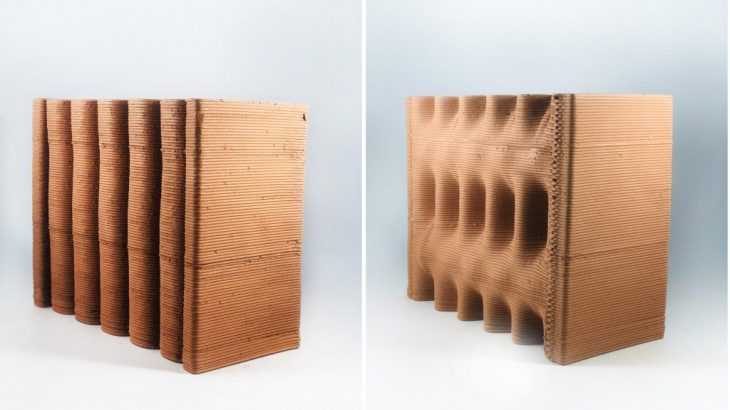
Quantitative analysis
The quantitative analysis is done based on a thermal variable on each system applying different iterations of Cavity/Skin/Surface/envelope design to mitigate alternate options of minimal heating loads. Using prototype models to create environmental conditions that approximate the real world simulations through the thermal box, analysing through a thermal camera and thermistor sensor for indoor and mass temperatures. Digital Thermal simulation using Grasshopper’s Climatic analysis tools for studying thermal transmittance of clay is modelled in honeybee energy modelling.
Moreover, CFD cloud computing Sim-scale is used to process the simulation of cavity air studies inside the cavity components
The whole experiment is carried out following a series of process. Which include 3D printing the geometry in 1:20 scale, Proper drying, fixing proper inlet and outlet for heat, compressed Infill mass using clay ( here we used powder clay ), adding thermal sensor into a thermal mass, proper sealing of wall within the window, Heating the wall and recording the indoor and thermal mass temperature.


Physical Thermal Model
A thermal model is a simple heating mechanism to prototype the idea of heating and distribution in a system. The entire box is covered with double-wall with proper insulation. The scaled model of clay 3D printed wall will place on the window on the wall and heat is supplied through the bottom.

Measurement system which includes a thermal camera for exterior surface temperature and two thermistors to measure interior and mass temperature resulting in a realtime graph mapping via the serial output

Thermal box components include the mass to be heated, insulation for the interior space and outer covering panel
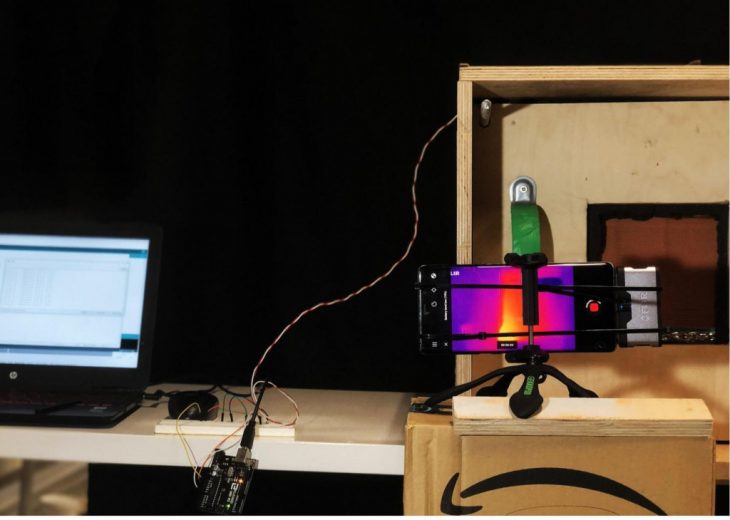
Data comparison
The rate of change of velocity is calculated by keeping temperature rate, time, and Volume constant. The result shows keeping the volume of the cavity constant, increasing time lag creates better heat distribution around the space. Hereunder the relation between a CFD result with a thermal image of an evenly distributed catalogue sample with sectioned model after a physical test.

Result Interpretation
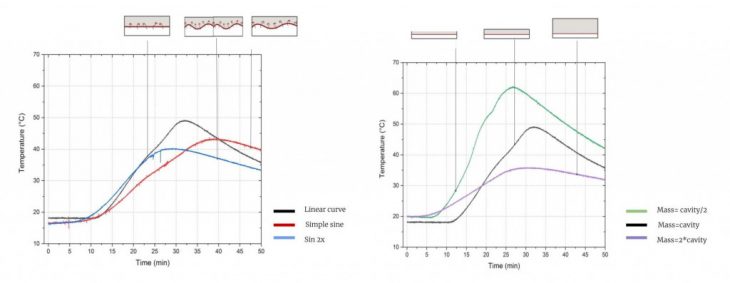
The realtime data of physical testing shows that the performance could be enhanced by altering the thermal mass and surface area of exposure for even distribution and coupled heating.
Conclusion
” A 3D printed wall ‘cavity’ for distribution of heat helps for better indoor heating for enhanced sustainable use of resources. “
The shape of the channel can be decided based on the position of heat requirement ( Point to point /bifurcation ) and the property of thermal mass for retaining heat while heat passes through it facilitate effective and sustainable indoor heating using an active heat source.
Prototype-based on research
Base geometry in 1:1

Heat path definition based on surface exposure

A study on Area of contact on thermal mass by the flow of heat along the surface.
In the vernacular Russian heating system, the distribution systems are consist of channel sections and bells. The channel sections are directed to the destination on different path and sizes are differentiated based on the intensity of heat required. The Area where more heated is comprised of chambers named as Bells. The advanced 3D printing allows creating sections of different sizes based on the requirements of heat.
Integration of bell and heat path
The different heat flows are simulated and analysed based on the maximum area of contact, size of bells, the structure of geometry and performance

Final heat path

Heat path

Final heat path integration with a bell that is visible through axis FF.Adding structural variables with the existing heat path for finalising the geometry.

The final geometry is defined by understanding the resolution of modules can be increased to achieve maximum slope for vertical heat movement. The size of modules can be parameterized based on the slope of the heat path

Printed prototype of 1:5

Testing
Below shows the time-lapse of the heating procedure from 00 to 03 hr. Active heating is applied using a gas torch from 00 hr to 01 hr which leads to heating of the mass. The mass in turn radiating the heat between 01 hr to 05hr without an active source, which contains from an active source for the remaining 04 hrs. The thermal image below from 00 hr until it heats shows a yellowish room temperature between 15-18 c, between 01-02hrs a massive increment around the bell is noted to be the maximum temperature around the whole object which is around 42-51 c. The testing procedure shows the effectiveness of integration of bells with the cavity of 3D printed wall for sustainable heat distribution.

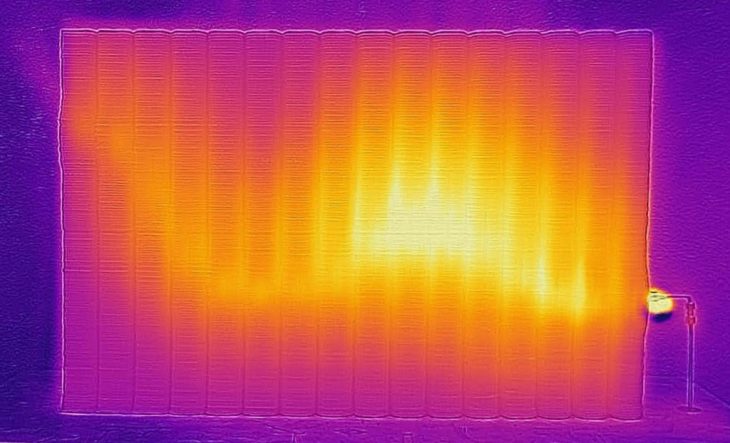
Conclusion
The research is a witness that in the near future, the efficiency of the 3dpa wall will able to replace conventional wall for the sustainable application of passive heating strategies in the content of passive built environment design regarding heating and cooling demand of a building.
878 JKGC is a project of IaaC, Institute for Advanced Architecture of Catalonia developed at Open Thesis Fabrication in 2020/2021 by:Students: Roshin Anthooravalappil |Teklehaymanot Woldesenbet|Timur Mukhametkaliyev Faculty: Edouard Cabay | Alexander Dubor | Kunaljit Chadha | Ashkan Foroughi Dehnavi
